 Real
Name: Unknown
Real
Name: Unknown
Identity/Class: Normal human
Occupation: Master criminal
Affiliations: Lady Beltham, Hélène, Vladimir, Bouzille (a tramp who sometimes also aided Juve)
Enemies: Jérôme Fandor (reporter for La Capitale newspaper), Inspector Juve
Known Relatives: Hélène (daughter), Juve (alleged brother), Vladimir (son), Countess de Pleumain (daughter-in-law, deceased),Jérôme Fandor (sometimes suspected of being Fantômas' son)
Aliases: l'Empéreur du Crime (the Emperor of Crime), Bouzille
Base of Operations: France
First Appearance: Fantômas (novel published by 1911)
Powers/Abilities: Master of disguise. Master plotter.
History: "Fantomas."
"What did you say?"
"I said: Fantomas."
"And what does that mean?"
"Nothing... And everything!"
"But what is it?"
"Nobody... And yet, it is somebody!"
"And what does that somebody do?"
"Spreads terror!"
The greatest and most ruthless of all French master criminals, Fantômas threatened the world repeatedly during the first couple of decades of the twentieth century. A master of disguise, there is no definitive description of the "Emperor of Crime", but his name became a byword for fear and death across France. Sometimes he killed in person, catching his victims unaware in the guise of a policeman or a nun, other times he killed hundreds at a distance, as when he deliberately released plague-infected rats on an ocean liner, exposing 500 passengers to a slow and painful death. Even his family were not safe; Countess de Pleumain, his innocent daughter-in-law, died at Fantômas' hands.
Standing between Fantômas and world domination was the police detective Juve, who might secretly have been the criminal's own brother, and whose own superiors sometimes suspected him of being the very criminal he pursued so monomaniacally. Aiding Juve was the youthful journalist Jerôme Fandor, who would later romance Fantômas' daughter Hélène, almost as evil as her father; though drawn to Fandor, the opium-smoking, death's-head-tattooed ingenue found his enmity of her father an insurmountable obstacle to their passion. The criminal's lover, Lady Beltham, widow of one of his victims, nonetheless loved Fantômas dearly, but was horrified by his villainy; however, whenever she tried to break away from him, she found herself irresistibly drawn back to him. While the women in his life found themselves with divided loyalties, Fantômas' son, the murderous Vladimir, had no such problems. Fantômas was also aided by an army of thugs, with spies and henchmen everywhere; any who dissented against his orders suffered brutal demises, setting examples for the rest of his men. Though his crimes might be thwarted, Fantômas himself was never apprehended.
"Oh, curse him! Fantomas has escaped! Fantomas has gotten away! He has had some innocent man executed in his stead! I tell you, Fantomas is alive!" (from the last chapter of the original novel)
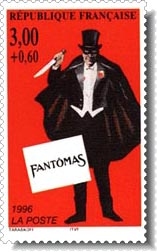 Comments: Created by Marcel Allain and Pierre Souvestre. Together
they penned thirty-two volumes of the series between 1911 and 1914, before
Souvestre died from Spanish Influenza and Allain enlisted in the army to
fight the invading Germans. In 1925 Allain returned to writing Fantômas
tales, adding eleven more to the canon. The first seven, #10 and #33-37 were
released with English translations in the 1910/20s, and the first two again
(with all-new translations) by Ballantine, in the 1980s.
Comments: Created by Marcel Allain and Pierre Souvestre. Together
they penned thirty-two volumes of the series between 1911 and 1914, before
Souvestre died from Spanish Influenza and Allain enlisted in the army to
fight the invading Germans. In 1925 Allain returned to writing Fantômas
tales, adding eleven more to the canon. The first seven, #10 and #33-37 were
released with English translations in the 1910/20s, and the first two again
(with all-new translations) by Ballantine, in the 1980s.
-
Fantômas (1911)
-
Juve contre Fantômas (1911; Juve vs. Fantomas, a.k.a. The Exploits Of Juve, a.k.a. The Silent Executioner)
-
Le Mort qui Tue a.k.a. Fantômas Se Venge (1911; The Dead Man Who Kills / The Vengeance of Fantomas, a.k.a. Messengers Of Evil)
-
L'Agent Secret a.k.a. Une Ruse de Fantômas (1911; The Secret Agent / A Ruse of Fantomas, a.k.a. A Nest Of Spies)
-
Un Roi Prisonnier de Fantômas (1911; A King Prisoner Of Fantomas a.k.a. A Royal Prisoner)
-
Le Policier Apache a.k.a. Le Policier Fantômas (1911; The Apache Policeman / Fantomas Policeman, a.k.a. The Long Arm Of Fantomas)
-
Le Pendu de Londres a.k.a. Aux Mains de Fantômas (1911; The Hanger Man of London / In the Hands of Fantomas, a.k.a. Slippery as Sin)
-
La Fille de Fantômas (1911; The Daughter of Fantomas)
-
Le Fiacre de Nuit a.k.a. Le Fiacre de Fantômas (1911, The Night Hansom Cab / The Hansom Cab of Fantomas)
-
La Main Coupée a.k.a. Fantômas à Monaco (1911; The Severed Hand / Fantomas in Monaco, a.k.a. The Limb Of Satan)
-
L'Arrestation de Fantômas (1911; The Capture of Fantomas)
-
Le Magistrat Cambrioleur a.k.a. Le Juge Fantômas (1912; The Burglar Judge / Judge Fantomas)
-
La Livrée du Crime a.k.a. La Livrée de Fantômas (1912; The Livery of Crime / The Livery of Fantomas)
-
La Mort de Juve a.k.a. Fantômas Tue Juve (1912; The Death of Juve / Fantomas Kills Juve)
-
L'Evadée de Saint-Lazare a.k.a. Fantômas, Roi du Crime (1912; The Escapee from Saint-Lazare / Fantomas, King of Crime)
-
La Disparition de Fandor a.k.a. Fandor Contre Fantômas (1912; The Disappearance Of Fandor / Fandor vs. Fantomas)
-
Le Mariage de Fantômas (1912; The Wedding Of Fantomas)
-
L'Assassin de Lady Beltham a.k.a. Les Amours de Fantômas (1912; The Assassin Of Lady Beltham / The Loves Of Fantomas)
-
La Guêpe Rouge a.k.a. Un Défi de Fantômas (1912; The Red Wasp / The Challenge Of Fantomas)
-
Les Souliers du Mort a.k.a. Fantômas Rôde (1912; The Dead Man's Shoes / Fantomas Prowls)
-
Le Train Perdu a.k.a. Le Train de Fantômas (1912; The Lost Train / The Train Of Fantomas)
-
Les Amours d'un Prince a.k.a. Fantômas s'amuse (1912; The Love Of A Prince / Fantomas Has Fun)
-
Le Bouquet Tragique a.k.a. Le Bouquet de Fantômas (1912; The Tragic Bouquet / The Bouquet Of Fantomas)
-
Le Jockey Masqué a.k.a. Fantômas, Roi du Turf (1913; The Masked Jockey / Fantomas, King Of The Turf)
-
Le Cercueil Vide a.k.a. Le Cercueuil de Fantômas (1913; The Empty Coffin / The Coffin Of Fantomas)
-
Le Faiseur de Reines a.k.a. Fantômas Contre l'Amour (1913; The Queen Maker / Fantomas vs. Love)
-
Le Cadavre Géant a.k.a. Le Spectre de Fantômas (1913; The Giant Corpse / The Spectre Of Fantomas)
-
Le Voleur d'Or a.k.a. Prisonniers de Fantômas! (1913; The Gold Thief / Prisoners Of Fantomas!)
-
La Série Rouge a.k.a. Fantômas s'évade (1913; The Red Series / Fantomas Escapes)
-
L'Hôtel du Crime a.k.a. Fantômas accuse! (1913; Crime Hotel / Fantomas Accuses!)
-
La Cravate de Chanvre a.k.a. Le Domestique de Fantômas (1913; The Hemp Necktie / The Servant Of Fantomas)
-
La Fin de Fantômas a.k.a. Fantômas Est-Il Mort? (1913; The End Of Fantomas / Is Fantomas Dead?)
-
Fantômas est-il ressuscité? (1925; Is Fantomas Resurrected?, a.k.a. The Lord Of Terror)
-
Fantômas, Roi des Recéleurs (1926; Fantomas, King Of The Fences a.k.a. Juve In The Dock)
-
Fantômas en Danger (1926; Fantomas In Danger, a.k.a. Fantomas Captured)
-
Fantômas prend sa Revanche (1926; Fantomas Takes His Revenge, a.k.a. The Revenge Of Fantomas)
-
Fantômas Attaque Fandor (1926; Fantomas Attacks Fandor, a.k.a. Bulldog And Rats)
-
Si c'était Fantômas? (1933; If It Was Fantomas?)
-
Oui, c'est Fantômas! (1934; Yes, It Is Fantomas!)
-
Fantômas Joue et Gagne (1935; Fantomas Plays And Wins)
-
Fantômas Rencontre l'Amour (1946; Fantomas Meets Love)
-
Fantômas Vole des Blondes (1948; Fantomas Steals From The Blondes)
-
Fantômas Mène le Bal (1963; Fantomas Leads The Dance)
Black Coat Press have recently released the first English translation of the eighth Fantomas novel "The Daughter of Fantomas".
The first Fantômas book cover, showing a contemplative masked man dressed in a dinner jacket and holding a dagger, boldly stepping over Paris, was so well known that it has almost become a cliché today. Just as Sherlock Holmes was the archetypal modern detective, Fantômas was the archetypal modern arch-villain. Among his better-known (and even more horrific) literary descendants were the Italian super-villains Diabolik, Satanik, and Kriminal.
In 1913 Gaumont Pictures produced the first film adaptation of Fantômas, with René Navarre in the title role, a three hour version of the original novel split into hour long episodes. Others swiftly followed, and by the end of the year five of Fantômas stories had been filmed over 32 hour long episodes.
-
Fantômas (1913)
-
Juve Contre Fantômas (Juve vs. Fantômas, 1913)
-
Le Mort Qui Tue (The Dead Man Who Kills, 1913)
-
Fantômas contre Fantômas (Fantomas vs. Fantomas, 1914)
-
Le Faux Magistrat (The Phony Magistrate, 1914)
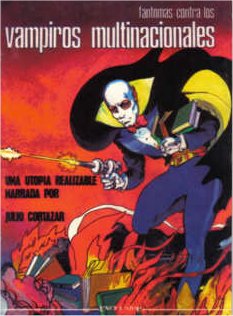 There
have also been several South American adaptations of
There
have also been several South American adaptations of
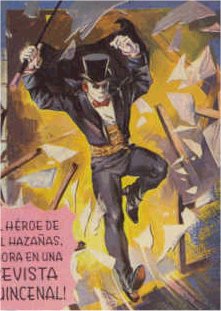 , though how faithful they are to the source character is uncertain.
, though how faithful they are to the source character is uncertain.
Much of the information on this page comes verbatim from Cool French Comics, used with permission.
CLARIFICATIONS: Not to be confused with
-
Fantomah, Golden Age heroine
Any Additions/Corrections? Please let me know.
All images and characters depicted on this site are copyright their respective holders, and are used for informational purposes only. No infringement is intended and copyrights remain at source.
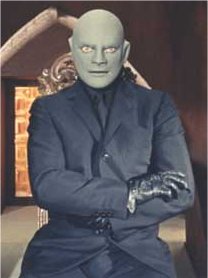
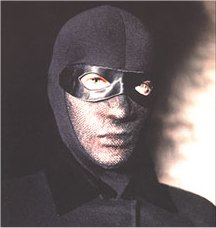 On radio Paul Bernard provided the master villain's voice in
60 episodes of an RTF series Fantômas which aired between 12th
November 1946 and 17th January 1947. RTF repeated the idea with 256 episodes
of a new series, also entitled Fantômas, which came out between
8th May 1973 and 16th August 1974, starring Roger Carel as the villain. It
wasn't until 1980 that Fantômas made it to television, with four 90
minute episodes adapting the original tale and starring Helmut Berger. Further
radio series followed in 1984, with La Fin de Fantômas (The
End of Fantômas), a feature-length broadcast starring Philippe Clay.
In 1991 Med Hondo played the part while Michael Lonsdale read an excerpt
from the novel for France-Culture as part of the anthology series
Héros du Roman Noir Français (Heroes of French Gothic
Novels).
On radio Paul Bernard provided the master villain's voice in
60 episodes of an RTF series Fantômas which aired between 12th
November 1946 and 17th January 1947. RTF repeated the idea with 256 episodes
of a new series, also entitled Fantômas, which came out between
8th May 1973 and 16th August 1974, starring Roger Carel as the villain. It
wasn't until 1980 that Fantômas made it to television, with four 90
minute episodes adapting the original tale and starring Helmut Berger. Further
radio series followed in 1984, with La Fin de Fantômas (The
End of Fantômas), a feature-length broadcast starring Philippe Clay.
In 1991 Med Hondo played the part while Michael Lonsdale read an excerpt
from the novel for France-Culture as part of the anthology series
Héros du Roman Noir Français (Heroes of French Gothic
Novels).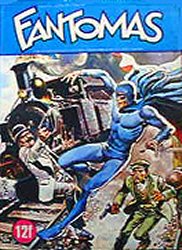 Wartime censorship curtailed the first Fantômas comic
strip, Fantômas contre les Nains (Fantomas vs. the Dwarves).
A weekly color page written by Marcel Allain and drawn by P. Santini, it
was published in "Gavroche" #24-30 in 1941. A sequel, Fantômas et
l'Enfer Sous-Marin (Fantomas and the Undersea Hell) was written but not
published. A more successful run of a daily black&white strip was syndicated
by Opera Mundi between November 1957 to March 1958, adapting the first two
novels over a total of 192 episodes. Seventeen Fantômas fumetti
(photo-novels) magazines adapting Nos 1, 2, 3 and 5 of the book series were
published by Del Duca in 1962 and 1963. A new weekly, color page, written
by Agnès Guilloteau and drawn by Jacques Taillefer, was again syndicated
by Opera Mundi in 1969 and published in "Jours de France". Finally, a series
of Fantômas graphic novels written by L. Dellisse and drawn by Claude
Laverdure were published by Belgian publisher Claude Lefrancq in its
"BDetectives" imprint, starting in 1990:
Wartime censorship curtailed the first Fantômas comic
strip, Fantômas contre les Nains (Fantomas vs. the Dwarves).
A weekly color page written by Marcel Allain and drawn by P. Santini, it
was published in "Gavroche" #24-30 in 1941. A sequel, Fantômas et
l'Enfer Sous-Marin (Fantomas and the Undersea Hell) was written but not
published. A more successful run of a daily black&white strip was syndicated
by Opera Mundi between November 1957 to March 1958, adapting the first two
novels over a total of 192 episodes. Seventeen Fantômas fumetti
(photo-novels) magazines adapting Nos 1, 2, 3 and 5 of the book series were
published by Del Duca in 1962 and 1963. A new weekly, color page, written
by Agnès Guilloteau and drawn by Jacques Taillefer, was again syndicated
by Opera Mundi in 1969 and published in "Jours de France". Finally, a series
of Fantômas graphic novels written by L. Dellisse and drawn by Claude
Laverdure were published by Belgian publisher Claude Lefrancq in its
"BDetectives" imprint, starting in 1990: